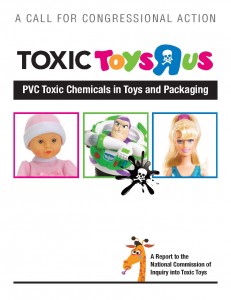Just when you thought it was safe to go back down the toy aisle...
Toys "R" Us - you've been very naughty these past few years.
We were esctatic back in 2008 when Toys R Us pledged to reduce the use of PVC and offer more PVC-free products. Unfortunately they haven't kept their word.
That's why we and the Teamsters Office of Consumer Affairs have released a new report, Toxic Toys R Us – PVC Toxic Chemicals in Toys and Packaging.
We wanted to find out whether or not Toys R Us did the right thing and ditched the poison plastic. The new investigation found Toys R Us has broken their promises to reduce the use of PVC and offer more PVC-free products.
Our new investigation found:
- PVC widespread in toys: 72% of all toys tested contained high levels of chlorine, indicating they were most likely made of PVC.
- Toxic additives in PVC toys: 20% of all toys tested contained tin, indicating the likely presence of organotins in the toys.
- PVC widespread in packaging: 52% of all toy packaging tested contained high levels of chlorine, indicating they were most likely made of PVC.
- Toxic additives in PVC packaging: 52% of all toy packaging tested contained tin, indicating the likely presence of organotins.
- Inadequate labeling: Most toys that tested positive for PVC were not labeled s such. In the testing this fall, just one of the 60 products that we tested was labeled as containing PVC, and this label was hidden and only apparent after purchasing product.
"Two years ago, Toys R Us made parents a promise to reduce the use of toxic PVC in children’s toys. Our tests show that Toys R Us has broken that promise,” said Lois Gibbs, Executive Director of the Center for Health, Environment & Justice. “As a grandmother, I have to watch out for PVC toys on my grandbabies’ Christmas lists. Santa should never have to say no because a toy is made out of a poison plastic. There should only be toys under the Christmas tree; not toxic additives like organotins"
The toxic shell game: hazardous organotins replacing lead.
In order to make toys out of PVC, plasticizers and stabilizers, such as lead, phthalates and organotins, must be added to the PVC formulation. Without these additives, it’s not possible to use PVC to make toys or to create packaging.
According to the findings of this investigation, it now appears that the company and its suppliers may simply have substituted one toxic additive, lead, for another, organotins.
Organotins, which were introduced to replace toxic metal stabilizers like lead and cadmium in PVC manufacturing, are also toxic and have also been found to leach from PVC products. Organotins affect the central nervous system, skin, liver, immune system and reproductive system. The diorganotins, such as dioctyltin, can adversely impact child development and can cause birth defects.
Since the organotins and other additives are not chemically bound to the PVC in toys, they can migrate from within the toys to the surface. In turn, children may be exposed to these hazardous substances by playing with, chewing on, or sucking on the toys.
Whether it’s lead or the organotins, the best approach to avoiding the various toxic additives is to avoid toys and products made of PVC.
Respected scientists endorse the report's recommendations.
After we wrote the report, we solicited environmental health experts, as part of a Commission of Inquiry into Toxic Toys, for both their review and opinion on our report findings. The Commission was chaired by Dr. Peter Orris, Professor and Chief of Service, Occupational and Environmental Medicine at the University of Illinois at Chicago Medical Center. Here's what he had to say about our report today:
"In order for PVC to be used in toys, it must be mixed with lead, cadmium or organic chemicals containing tin. These chemicals are all toxic to children when ingested," said Dr. Peter Orris. "In particular they are all linked with potential brain damage. Because these chemicals are not tightly bound to the plastic they can enter children's bodies when the children chew or suck on the toys or PVC-containing packaging that the toys come in."
Toxic PVC toys.
Toys that tested positive for PVC include Barbie, “Toys Story 3” Woody and Buzz Lightyear figures, Disney Princess Royal Giggles doll, Zhu Zhu Pets Hamster Hangout, Nickelodeon’s Dora the Explorer and Diego figures, Sesame Street Elmo Faucet Cover, Club Penguin figurines, Imaginext toddler action figures and many others, from dolls and balls, to baby bath time toys and products, and even My Name Sippy Cups. PVC was also found in toys whose brands are owned by Geoffrey LLC, a subsidiary of Toys “R” Us, including You and Me dolls, Especially for Baby, and Sizzlin’ Time items.
PVC and organotins in toys intended for infants and young children.
Many of the PVC toys we found were marketed for infants and young children, and some also contained toxic organotins. We found:
- 67% of fall 2010 toys marketed to infants 3-12 months and up in age contained chlorine, indicating they were likely made of PVC. 17% of these age-targeted group toys contained tin, indicating the likely presence of organotins in these toys.
- 81% of fall 2010 toys marketed to children 18-36 months and up in age contained chlorine, indicating they were likely made of PVC. 19% of these age-targeted group toys contained tin, indicating the likely presence of organotins in these toys.
- 62% of fall 2010 toys marketed to children 4-6 years and up in age contained chlorine, indicating they were likely made of PVC. 46% of these age-targeted group toys contained tin, indicating the likely presence of organotins.
Toys "R" Us has the power to get toxics out.
Toys “R” Us is the largest specialty retailer of toys in the United States. With more than $13 billion in annual revenues and more than 1,550 stores worldwide, Toys “R” Us has a major influence on the toy market.
As one of the largest toy retailers in the world, Toys “R” Us has the power and the responsibility to sell toys that are safe for our health and the environment and free of harmful plastics such as PVC.
We need your help to send Toys "R" Us a strong message - will you join us?



The views and opinions expressed in this post are those of the author(s) and do not necessarily reflect those of MomsRising.org.
MomsRising.org strongly encourages our readers to post comments in response to blog posts. We value diversity of opinions and perspectives. Our goals for this space are to be educational, thought-provoking, and respectful. So we actively moderate comments and we reserve the right to edit or remove comments that undermine these goals. Thanks!